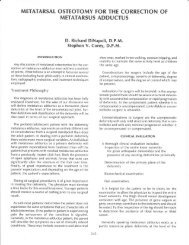56CHAPTER 12Figure 14. The con<strong>to</strong>ured cup <strong>and</strong> dome fit.addition, <strong>the</strong> rongeur instrument will <strong>of</strong>ten result inincomplete cartilage removal on <strong>the</strong> middle phalanx, afunction <strong>of</strong> <strong>the</strong> mismatch between <strong>the</strong> phalangeal surface<strong>and</strong> <strong>the</strong> tip <strong>of</strong> <strong>the</strong> instrument. This incomplete tissue removalwill lead <strong>to</strong> osseous union problems.ANATOMIC APPROACHTO JOINT RESECTIONJoint <strong>preparation</strong> is very tedious <strong>and</strong> more <strong>of</strong>ten than notimperfect. The ideal operation would be a rapid jointdisarticulation, rapid <strong>and</strong> precise cartilage removal as withh<strong>and</strong> instruments without excessive s<strong>of</strong>t tissue disruption orheat generation seen with powered instruments, <strong>and</strong> perfectapproximation <strong>of</strong> <strong>the</strong> bone ends after cartilage removal.These fac<strong>to</strong>rs led <strong>to</strong> <strong>the</strong> development <strong>of</strong> a micro-reamingsystem, one that combines <strong>the</strong> precision <strong>and</strong> control <strong>of</strong> h<strong>and</strong>instrumentation with <strong>the</strong> rapid tissue removal <strong>of</strong> a poweredinstrument (Figures 16, 17). The instruments reducedoperating time, completely <strong>and</strong> uniformly removed articulartissue, increased surface area <strong>of</strong> <strong>the</strong> <strong>fusion</strong> mass, <strong>and</strong> reduce<strong>to</strong>tal bone loss. The corresponding reamers attach <strong>to</strong>st<strong>and</strong>ard Kirschner wire (K-wire) drivers which run atvariable speeds, a function that allows for slow or rapidremoval <strong>of</strong> bone tissue (Figures 18, 19). The devices have aclosed periphery, preventing additional s<strong>of</strong>t tissue damageby enclosing <strong>the</strong> cutting device <strong>and</strong> restricting tissue removal<strong>to</strong> <strong>the</strong> area within a dome. The amount <strong>of</strong> bone removedcan be finely adjusted by <strong>the</strong> number <strong>of</strong> revolutions <strong>of</strong> <strong>the</strong>cutter on <strong>the</strong> bone, a function <strong>of</strong> two variables directlycontrolled by <strong>the</strong> surgeon: <strong>the</strong> speed <strong>of</strong> <strong>the</strong> drill <strong>and</strong> <strong>the</strong>pressure delivered <strong>to</strong> <strong>the</strong> instrument. The dome-shapedcutter leaves behind a rounded edge, eliminating sharpcorners in <strong>the</strong> prepared joint. The instrument also generatesvery little heat, a function <strong>of</strong> variable speed tissue removal,extremely sharp cutting edges, <strong>and</strong> large openings in <strong>the</strong>Figure 15. Most digital length is lost in <strong>the</strong>unnecessarily deep transverse resection <strong>of</strong> <strong>the</strong> head <strong>of</strong><strong>the</strong> proximal phalanx. Dome resection <strong>of</strong> <strong>the</strong> head <strong>of</strong><strong>the</strong> phalanx achieves <strong>the</strong> desired tissue removal whileminimizing shortening, an important considerationin <strong>the</strong> maintenance <strong>of</strong> <strong>the</strong> <strong>ana<strong>to</strong>mic</strong> digital parabola<strong>and</strong> in revision surgery.cutters <strong>to</strong> reduce surface area contact <strong>of</strong> noncutting surfaceswith <strong>the</strong> bone.Ana<strong>to</strong>mic position is critical <strong>to</strong> <strong>the</strong> success <strong>of</strong> <strong>the</strong>arthrodesis procedure. One <strong>of</strong> <strong>the</strong> drawbacks <strong>to</strong> traditionalpowered saws is that <strong>the</strong> freeh<strong>and</strong> cut on two adjacent bonesis not connected. It is difficult <strong>to</strong> visualize <strong>the</strong> final position<strong>of</strong> <strong>the</strong> fused bones while making <strong>the</strong> osteo<strong>to</strong>my withoutapproximating <strong>and</strong> <strong>of</strong>ten fixating <strong>the</strong> bones <strong>to</strong>ge<strong>the</strong>r. It iscommon <strong>to</strong> take <strong>the</strong> fixation out, <strong>and</strong> revise <strong>the</strong> bone cut inorder <strong>to</strong> gain better approximation <strong>of</strong> <strong>the</strong> ends. It is likewisedifficult <strong>to</strong> appreciate <strong>the</strong> hills <strong>and</strong> valleys on adjacentsides <strong>of</strong> <strong>the</strong> prepared joint until <strong>the</strong> ends are brought<strong>to</strong>ge<strong>the</strong>r. The dome reamer eliminates this problem. Thecorresponding cup reamer creates a recess in <strong>the</strong> middlephalanx with specific geometry for <strong>the</strong> reamed proximalphalangeal head <strong>to</strong> seat in. The concavity is just fractionallylarger than <strong>the</strong> convexity. This permits <strong>the</strong> surgeon <strong>to</strong> place<strong>the</strong> <strong>to</strong>e in any position <strong>and</strong> have direct contact <strong>of</strong> bone ends.The process <strong>of</strong> fixation-assessment-revision-refixation is <strong>the</strong>navoided, since use <strong>of</strong> corresponding reamers will alwaysresult in direct <strong>and</strong> complete apposition <strong>of</strong> bone ends.The cutting portions <strong>of</strong> <strong>the</strong> reamer sit behind a leadingtrocar-pointed segment <strong>of</strong> wire. This lead serves threepurposes; first, <strong>the</strong> trocar pointed segment leads <strong>the</strong> cutterdown <strong>the</strong> medullary center <strong>of</strong> <strong>the</strong> cylindrical bone, thus <strong>the</strong>device is self-centering; second, <strong>the</strong> lead steadies <strong>the</strong> bone<strong>and</strong> <strong>the</strong> reamer such that when <strong>the</strong> cutting device actuallycontacts <strong>and</strong> begins reaming, <strong>the</strong> assembly is stabilizedagainst bending <strong>and</strong> slippage; <strong>and</strong> third, <strong>the</strong> pointed leadalso predrills for intended fixation, leaving behind centrallylocated corresponding holes in both <strong>the</strong> proximal <strong>and</strong>middle phalanx for placement <strong>of</strong> fixation.
CHAPTER 12 57JOINT FIXATIONThe st<strong>and</strong>ard technique for <strong>interphalangeal</strong> joint fixationinvolves <strong>the</strong> use <strong>of</strong> K-wires, placed from within <strong>the</strong> preparedjoint, exiting <strong>the</strong> <strong>to</strong>e, <strong>the</strong>n retrograded back in<strong>to</strong> <strong>the</strong> base <strong>of</strong><strong>the</strong> proximal phalanx. Wire fixation is made easier bypredrilling a hole in <strong>the</strong> proximal phalanx prior <strong>to</strong>retrograding <strong>the</strong> wire. This maneuver will centralize <strong>the</strong>middle phalanx on <strong>the</strong> proximal phalanx when <strong>the</strong> bones areapproximated as stated above.The reamer instruments are affixed <strong>to</strong> a bore <strong>of</strong> <strong>the</strong> samedimensions as a traditional K-wire. This bore is <strong>the</strong> couplingthat allows <strong>the</strong> cutter <strong>to</strong> connect <strong>to</strong> <strong>the</strong> myriad <strong>of</strong>st<strong>and</strong>ardized power instruments. This bore also provides <strong>the</strong>user with a built in fixation device, once <strong>the</strong> cutting section<strong>of</strong> <strong>the</strong> wire is removed. The remaining wire is <strong>the</strong> exactdiameter <strong>of</strong> <strong>the</strong> lead that has already predrilled <strong>the</strong> bones.Consequently, <strong>the</strong> surgeon has in his h<strong>and</strong> a singleinstrument for cutting <strong>and</strong> fixating a digital arthrodesis.CONCLUSIONDigital arthroplasty <strong>and</strong> arthrodesis are among <strong>the</strong> mostcommonly performed operations in foot <strong>and</strong> ankle surgery.The surgical technique has remained relatively unchangedfor many years, despite <strong>the</strong> fact that <strong>the</strong> majority <strong>of</strong> <strong>the</strong>healing complications are a direct result <strong>of</strong> poor joint<strong>preparation</strong>. The benefits <strong>of</strong> con<strong>to</strong>ured resections <strong>of</strong> <strong>the</strong>ankle, subtalar, talonavicular, first metatarsophalangeal joint,<strong>and</strong> <strong>interphalangeal</strong> joints have been described in <strong>the</strong>literature. However, given <strong>the</strong> inherently rapid nature <strong>of</strong> <strong>the</strong>operation on <strong>interphalangeal</strong> joints con<strong>to</strong>ured resections atthis level are not commonly performed, <strong>and</strong> when <strong>the</strong>y areperformed <strong>the</strong>y are imperfect due <strong>to</strong> <strong>the</strong> inherent nature <strong>of</strong><strong>the</strong> instruments utilized. A great deal <strong>of</strong> attention is directedat fixation methods for this procedure, although <strong>the</strong> ability<strong>to</strong> enhance <strong>fusion</strong> rates <strong>and</strong> patient satisfaction may simply liein more careful, <strong>ana<strong>to</strong>mic</strong> <strong>preparation</strong> <strong>of</strong> <strong>the</strong> joint surfaces.Figure 16.Figure 17.Figure 18.Figure 19.
















